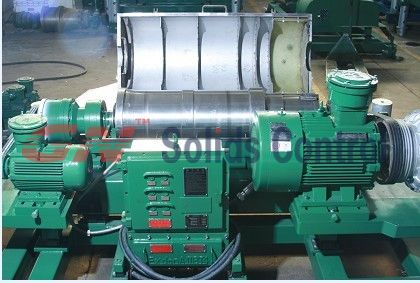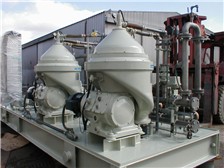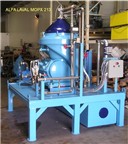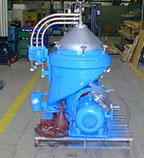Urenco is short for Uranium Enrichment Company. Three countries – Germany, the Netherlands and the United Kingdom – signed the Treaty of Alemlo (Netherlands) on March 4, 1970 as a way to collaborate in developing centrifuge technology for uranium enrichment.  In 1971, three industrial partners – British Nuclear Fuels plc (BNFL), Ultra-Centrifuge Nederland N.V. (UCN) and Uranit GmbH – founded Urenco Ltd.
In 1971, three industrial partners – British Nuclear Fuels plc (BNFL), Ultra-Centrifuge Nederland N.V. (UCN) and Uranit GmbH – founded Urenco Ltd.
The Louisiana Energy Services partnership plans on building the National Enrichment Facility (NEF) about five miles east of Eunice, New Mexico. The NEF plans on providing a sustainable domestic supply of slightly enriched uranium, also called ‘low enriched uranium’ or LEU, using Urenco’s gas centrifuge technology. Currently, USEC is the other uranium enrichment facility, using the more expensive gaseous diffusion technology. USEC is a publicly traded company, created under the Clinton-Gore Administration for the purposes of the Russia-US ‘swords for plowshares’ HEU deal. Under the HEU agreement, Russia’s counterpart supplied USEC with uranium from decommissioned Russian nuclear weapons. This uranium now supplies U.S. utilities with about 50 percent of the uranium used to power domestic nuclear power plants.
Under the HEU agreement, Russia’s counterpart supplied USEC with uranium from decommissioned Russian nuclear weapons. This uranium now supplies U.S. utilities with about 50 percent of the uranium used to power domestic nuclear power plants.
In 2001, the domestic uranium industry only produced 12 percent of its required supply of enriched uranium, while Russia exported 55 percent to the United States. Urenco supplied 16 percent of the U.S. demand. Urenco plans to increase its percentage of enriched uranium to about one-quarter of U.S. enrichment demand, once the plant is running at full capacity. This amounts to annual production of 3 million Separative Work Units (SWUs). A Separative Work Unit is the unit used to express the effort necessary to separate U-235 and U-238. The capacity of enrichment plants is measured in tons SW per year. For example, a large nuclear power station with a net electrical capacity of 1300 MW requires an annual amount of 25 tons SW (enriched uranium) to operate (with a concentration of 3.5 percent U-235).
The capacity of enrichment plants is measured in tons SW per year. For example, a large nuclear power station with a net electrical capacity of 1300 MW requires an annual amount of 25 tons SW (enriched uranium) to operate (with a concentration of 3.5 percent U-235).
The National Enrichment Facility will become Urenco’s North American debut of the company’s gas centrifuge technology, which the company boasts is the ‘world’s most advanced, energy-efficient and cost-effective uranium enrichment technology.’ It has reportedly been used for more than thirty years.
 In 1971, three industrial partners – British Nuclear Fuels plc (BNFL), Ultra-Centrifuge Nederland N.V. (UCN) and Uranit GmbH – founded Urenco Ltd.
In 1971, three industrial partners – British Nuclear Fuels plc (BNFL), Ultra-Centrifuge Nederland N.V. (UCN) and Uranit GmbH – founded Urenco Ltd.The Louisiana Energy Services partnership plans on building the National Enrichment Facility (NEF) about five miles east of Eunice, New Mexico. The NEF plans on providing a sustainable domestic supply of slightly enriched uranium, also called ‘low enriched uranium’ or LEU, using Urenco’s gas centrifuge technology. Currently, USEC is the other uranium enrichment facility, using the more expensive gaseous diffusion technology. USEC is a publicly traded company, created under the Clinton-Gore Administration for the purposes of the Russia-US ‘swords for plowshares’ HEU deal.
 Under the HEU agreement, Russia’s counterpart supplied USEC with uranium from decommissioned Russian nuclear weapons. This uranium now supplies U.S. utilities with about 50 percent of the uranium used to power domestic nuclear power plants.
Under the HEU agreement, Russia’s counterpart supplied USEC with uranium from decommissioned Russian nuclear weapons. This uranium now supplies U.S. utilities with about 50 percent of the uranium used to power domestic nuclear power plants.In 2001, the domestic uranium industry only produced 12 percent of its required supply of enriched uranium, while Russia exported 55 percent to the United States. Urenco supplied 16 percent of the U.S. demand. Urenco plans to increase its percentage of enriched uranium to about one-quarter of U.S. enrichment demand, once the plant is running at full capacity. This amounts to annual production of 3 million Separative Work Units (SWUs). A Separative Work Unit is the unit used to express the effort necessary to separate U-235 and U-238.
 The capacity of enrichment plants is measured in tons SW per year. For example, a large nuclear power station with a net electrical capacity of 1300 MW requires an annual amount of 25 tons SW (enriched uranium) to operate (with a concentration of 3.5 percent U-235).
The capacity of enrichment plants is measured in tons SW per year. For example, a large nuclear power station with a net electrical capacity of 1300 MW requires an annual amount of 25 tons SW (enriched uranium) to operate (with a concentration of 3.5 percent U-235).The National Enrichment Facility will become Urenco’s North American debut of the company’s gas centrifuge technology, which the company boasts is the ‘world’s most advanced, energy-efficient and cost-effective uranium enrichment technology.’ It has reportedly been used for more than thirty years.












